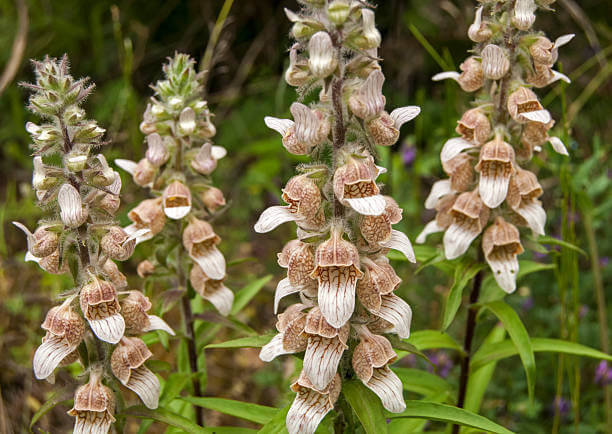- +033 2572 7171
- info@dhanvantary.com

4.5 Rating | 4500 Review

4.5 Rating | 4500 Review
Digitalis lanata is a species of foxglove usually known as woolly foxglove or Grecian foxglove. Digitalis lanata is poisonous in all parts of the plant like some other species of foxglove. Symptoms of digitalis poisoning include nausea, vomiting, dilated pupils, severe headache, eyesight problems, and convulsions at the critical level of toxicity.

In some cases, it is considered a noxious weed. Digitalis lanata found in leaf all year, in flower in month of June and July, and in early-mid September it is found in ripen seeds.
Kingdom
Plantae
Clade
Angiosperms
Clade
Eudicots
Clade
Asterids
Order
Lamiales
Family
Plantaginaceae
Genus
Digitalis
Species
D. lanata
Binomial Name
Digitalis lanata
Synonym
Digitalis orientalis, Digitalis nova
The plant grows wild everywhere in Europe, whereas it is cultivated in India, Holland and North America.
The leaves are the medicinal part of the plant.
Digitalis leaf shows a narrow therapeutic index, so close medical supervision is required for safe use. Traditional dosage starts at 1.5 g of a leaf which is given as two divided doses in a day. Purified digoxin dose is 0.125 to 0.25 mg daily.
It is powerful than Digitalis purpurea and is used as a source for the production of digoxin and other glycosides. Digoxigenin and Diginatigenin are specific for Digitalis lanata while others are present in Digitalis purpurea.
The chemical constituents present in Digitalis lanata are:-
Digitalis lanata contains a powerful cardiac glycoside which possesses positive isotropic effects due to inhibition of sodium-potassium adenosine triphosphatase, which allows accumulation of calcium in myocytes which leads to enhanced cardiac contractility. That may be used by patients with heart conditions.
Digoxin (digitalin) is extracted from Digitalis lanata. It is used to treat some heart diseases like atrial fibrillation. It reduces atrioventricular conduction so that the heartbeat slows down and slightly improves contraction power. Because of the improved circulation in congestive heart failure, the kidneys can work properly, which stimulates urine flow, and lowers the blood volume and reduces the load on the heart.
These drugs also have antiarrhythmic activity but at a higher dose, it will induce arrhythmias.
The cytotoxic properties of glycosides and flavonoids from Digitalis lantana and Digitalis purpurea shown by some In-vitro and screening studies. These show their activity against human cancer cell lines and solid tumor lines. The mechanism of Digitalis lanata against cancer includes direct cytotoxicity which results in apoptosis, inhibition of induction of nitric oxide synthase, inhibition of aflatoxin-induced cytotoxicity, and increases in the level of glutathione S-transferase.
Animal studies show the positive effects of Digitalis lanata on the lipid profile. Hyperglycemic and dyslipidemic rats showed enhanced glucose tolerance even after 2 hours of giving a single dose of the saponin digitonin to them.
There are also other commercial uses of Digitalis lanata other than heart diseases. For example, in South America, the powdered leaves of Digitalis lanata are used to relieve asthma, as sedatives and diuretics.
In India, it is also used as an ointment that includes digitalis glycosides and is used to treat wounds and burns.
There is various interaction with digoxin and digitalis glycosides. The use of Digitalis lanata with some drugs shows negative effects that may be ranging from minor to life-threatening effects. The drugs with Digitalis lanata that cause minor effects are such as cimetidine, triamterene. Many of the life-threatening interactions occur as a result of increased digoxin serum levels or electrolyte disturbances when Digitalis lanata was given with some drugs like amiodarone, cyclosporine, macrolide and tetracycline antibiotics, propafenone, quinidine, verapamil, and diuretics.
Adverse reactions of Digitalis lanata are generally related to toxicity. So complete and close medical supervision is required for safe use of Digitalis lanata.
All parts of this plant are toxic. Children have become unhealthy by engulfing the flowers or by eating seeds or leaves. It also becomes life-threatening among people who drank tea made from digitalis mistakenly. Although the bitter taste often prevents ingestion, and its emetic properties can produce vomiting, thereby this can limit the systemic absorption.
The accumulation and excretion of Digitalis glycosides are very slow therefore, intoxications during treatment are normal. Proper dosing guidelines and monitoring of the patient for safe use reduce the incidence of therapeutic overdose.
Signs of purified drug or plant poisoning include contracted pupils, blurred vision, excessive urination, fatigue, dizziness, muscle weakness, strong but slowed pulse, nausea, and vomiting. In severe cases, it includes confusion, convulsions, stupor, and even death can occur.
